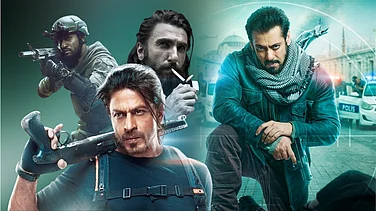“Every powerful image has a powerful story behind it”.
The resounding echo of this powerful statement in a flowing voice is what captures our imagination in the very first instance when we begin to view this documentary, which is a collection of enchanting stories. Soon, the vast expanse of wondrous nature is thrown open to us as the screen lights up gradually to the soft baritone of the narrator in Tales By Light, a Netflix Original docuseries that offers us a glimpse into the hitherto unknown realms of the sea, the desert and the land and their myriad creatures, their flora and fauna.
It is through the lens of the photographer that we travel from an active volcano (the Tavurvur Volcano) site in New Guinea to the adventurous high liners in Colorado and paragliders in Utah; from brown bears in the rivers of Alaska to the rare Gelada Baboons in the jungles of Uganda; from the natives of Masai Mara in South Africa to the breathtaking landscape of Antarctica; from the vibrant festival of Holi in India to the ancient cultures of the Surma in Ethiopia; from the largest and heaviest underwater sea creature, the green anaconda, of Brazil and the human-friendly tiger sharks in the Bahamas to the deserts of Namibia; from the dirty ravines of impoverished Bangladesh to the captivating marine wildlife of Raja Ampat Islands of Indonesia with its docile giant Manta Ray fish; and the aboriginals and their ancient rock art in Australia.

The captivating photography series has been directed and produced by Abraham Joffe ACS, an internationally acclaimed cinematographer with an eye for striking visual storytelling in the most pristine, aesthetic sense that compels the viewer to become a part of the larger canvas. It is through this exquisitely shot series that he brings together photographers from across the world who have taken this art form and the medium to new heights with their almost frenzied sense of purpose.
And that’s precisely why Tales By Light stands out. It imparts meaning to art that documents life—human, animal, and plant—through the lens of photographers who are out there in the remote corners of the world in the hope that their “photography will be a testament to the wonderful and mysterious complexities of our world”, as Stephen Dupont states in one of the episodes.
Passion is not the only thing that drives these men. They also have a fervent desire to “bring out the voice of the people who don’t have a voice”, says Dupont, who chronicled the horrors of war, famine and genocide in Africa and brought back forgotten stories even as “the impact that the dead had on me was quite unbelievable”. And so he picked up his camera, inspired by his stint in India, to “capture pictures that honour death in all its poetry”. His journey takes him to Namibia—the land of the Skeleton Coast, then to Deadvlei which he calls “an apocalyptic piece of visual poetry”, and finally to the Bushmen of Kalahari to document their ancient cultures surrounding death before they are lost to the changing world. What we get to see are the surreal images of the desert and the abandoned town captured through the changing light of the day in what appear like timeless shots framed for posterity.

The potential of the portraits of disadvantaged children by photographer Simon Lister was recognised by UNICEF in 2016. For him, photography is “a window into other parts of the world”, where armed with his camera that speaks a universal visual language, he can bring “the outside world in to see what I am seeing”.
In Dhaka, Bangladesh, along with UNICEF goodwill ambassador Orlando Bloom, he visits people living in hazardous conditions and child labourers working in risk-ridden industries and living in extreme brutal poverty and documents their lives through portraits of children, prints that are later used worldwide to highlight the cause.
Shawn Heinrichs, a marine conservationist, filmmaker and photographer, travels all the way to Isla Mujeres on the northern tip of the Yucatán Peninsula on an expedition to document whale sharks, to save and preserve the biodiversity of sea life so that he could show “the reality, the beauty, juxtaposed with the destruction”. He then decides to go to Raja Ampat Islands, Indonesia. Chasing down shark fin operations for five years, Heinrichs finally finds a shark shorn of fins, clicks pictures of the creature in pain, and gets in touch with Peter Knights, executive director, WildAid, who creates a high-impact campaign to spread awareness.
It works. “Imagery gives you a voice. Shark fin consumption was reduced by 70-80 per cent in China”. And there was a 400 per cent increase in terms of fish biomass! Through photography, he could not only save and conserve the world’s marine biodiversity by working closely with Conservation International (NGO), but also managed to have Raja Ampat declared a shark and ray sanctuary. “Art is my passion. But conservation is my purpose and for me the two are inseparable”, he says in the series.
In Victoria River, north of Alice Springs, Australia, Dylan River meets 87-year-old Bill Harney, a Wardaman elder, to document their distinct traditions, language, culture and rock art. And in Bawaka, he records, participates, understands and documents the life of the Yolngu people as they introduce him to the Bungul ceremony, a rare tradition that the outside world is not welcomed into.

Everything in Tales By Light, from the challenging topography to the profound and thought-provoking narrative, appears like nature’s symphony orchestrated by these talented men and their technology-driven cameras and drones. A lot of elaborate detailing and negotiation goes into planning a particular shot as envisaged by the photographer’s imagination. It is his vision that gets the perfect shot—a visual treat with mesmerisingly evocative images—that does justice to not merely his individual identity but to the greater purpose of the moments captured for future generations.
The sounds, the music, the voice, in both the narrative as well as the dialogues, are in sync with the corresponding scenes that transport you to another world. The three seasons of six episodes each, are not mere entertainment. While the first season is more about the preparation, composition and technique experimentation that goes into capturing the perfect shot, the second takes you a little ahead as these master craftsmen play with light and dark and camera angles to showcase a kaleidoscope of moving images.
Each protagonist weaves tales of relationships of living beings on earth with the boundless miracles of nature—all through his lens. The photographers’ dangerous liaisons with tough terrain and diverse natural landscapes tell tales that leave you with goosebumps. Engaging the camera with the subject and the landscape, each creates compelling images that have long-lasting impressions on the human mind and soul. Each frame comes forth as a piece of art.
Through the underwater scenes, the top of an active volcano site, a desolate town or the burning ghats of Varanasi, it is the poetic narrative that takes you on a journey that makes even the eerie and the ghostly seem lyrical and very much captures the essence of each episode in totality. A riveting and haunting detailed narrative voiceover and music make it a remarkable experience to watch a series that is painstakingly crafted with a purpose—to conserve, preserve, document, showcase, communicate valuable records, create compassion and new impressions, evoke emotion, save and protect the planet in every way.
Art, here, becomes a metaphor for uncertain future.
(Deepa Gupta is a journalist, writer and documentary scriptwriter)
























